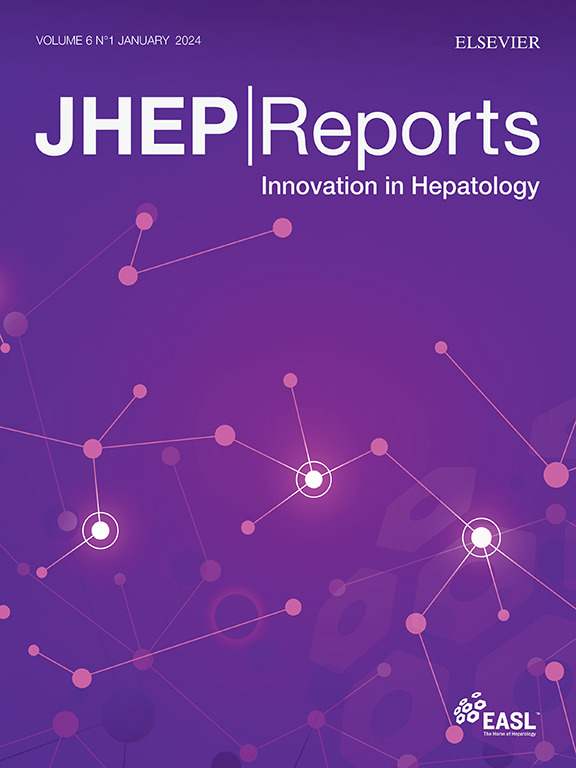Protective value of ischemia-free liver transplantation on post-transplant acute kidney injury
IF 9.5
1区 医学
Q1 GASTROENTEROLOGY & HEPATOLOGY
引用次数: 0
Abstract
Background & Aims
Ischemia-free liver transplantation (IFLT) completely avoids ischemia–reperfusion injury (IRI), thus potentially reducing acute kidney injury (AKI) after liver transplantation (LT). Therefore, this study investigated whether IFLT has a protective effect against AKI after LT.
Methods
In total, 862 patients who had undergone LT between 2017 to 2022 were divided into an ischemia-free liver transplantation group (IFLT group) and conventional liver transplantation group (CLT group) based on the surgical methods used. Propensity score matching (PSM) was used for post hoc randomization in the 1:1 matching between the groups. Post-transplant kidney function, graft function, and patient survival were compared between the groups. Multivariate logistic regression analysis was used to identify the risk factors of AKI after LT.
Results
Overall, 745 out of 862 patients were finally enrolled, of whom 98 underwent IFLT. PSM created 94 pairs of patients. IFLT resulted in a significant reduction in Stage-3 AKI (3.2% vs. 16.0%, p = 0.003), severe AKI (SAKI) (13.8% vs. 25.5%, p = 0.044), and renal replacement therapy (RRT) ratio (3.2% vs. 12.8%, p = 0.015) compared with the CLT group. The early allograft dysfunction (EAD) incidence of the IFLT group significantly decreased (8.5% vs. 44.7%, p <0.001). Livers from the extended criteria donation (ECD) were received in 49 patients who underwent IFLT and 46 patients who underwent CLT. Compared with the ECD-CLT group, the Stage-3 AKI and SAKI incidence in the ECD-IFLT group were both decreased (p <0.05). Multivariate logistic regression analysis further confirmed that both using IFLT and avoiding ECD were protective factors for post-transplant Stage-3 AKI.
Conclusions
IFLT significantly reduces the incidence of post-transplant SCKI, Stage-3 AKI, and RRT. Importantly, this protective effect is also present in patients receiving ECD livers.
Impact and implications
Ischemia-free liver transplantation significantly reduces the incidence of severe acute kidney injury, Stage-3 acute kidney injury and renal replacement therapy after liver transplantation. Importantly, this protective effect is also present in patients receiving extended criteria donation livers.
Clinical trial number
ChiCTR2400081755.

无缺血肝移植对移植后急性肾损伤的保护作用
背景,目的无缺血肝移植(IFLT)完全避免了缺血再灌注损伤(IRI),从而有可能减轻肝移植(LT)后的急性肾损伤(AKI)。方法将2017 - 2022年862例肝移植患者根据手术方式分为无缺血肝移植组(IFLT组)和常规肝移植组(CLT组)。采用倾向评分匹配(PSM)进行分组后随机化,组间1:1匹配。比较两组患者移植后肾功能、移植物功能及生存时间。采用多因素logistic回归分析确定lt后AKI的危险因素。结果862例患者中,最终纳入745例,其中98例接受了IFLT治疗。PSM创造了94对患者。与CLT组相比,IFLT显著降低了3期AKI (3.2% vs. 16.0%, p = 0.003)、严重AKI (SAKI) (13.8% vs. 25.5%, p = 0.044)和肾脏替代治疗(RRT)比率(3.2% vs. 12.8%, p = 0.015)。IFLT组早期同种异体移植物功能障碍(EAD)发生率显著降低(8.5% vs. 44.7%, p <0.001)。49名接受IFLT的患者和46名接受CLT的患者接受了扩展标准捐献(ECD)的肝脏。与ECD-CLT组相比,ECD-IFLT组3期AKI和SAKI发生率均降低(p <0.05)。多因素logistic回归分析进一步证实,使用IFLT和避免ECD是移植后3期AKI的保护因素。结论siflt可显著降低移植后SCKI、3期AKI和RRT的发生率。重要的是,这种保护作用也存在于接受ECD肝移植的患者中。影响和意义无化学肝移植可显著降低肝移植术后严重急性肾损伤、3期急性肾损伤和肾替代治疗的发生率。重要的是,这种保护作用也存在于接受延长标准捐献肝脏的患者中。临床试验编号chictr2400081755。
本文章由计算机程序翻译,如有差异,请以英文原文为准。
求助全文
约1分钟内获得全文
求助全文
来源期刊

JHEP Reports
GASTROENTEROLOGY & HEPATOLOGY-
CiteScore
12.40
自引率
2.40%
发文量
161
审稿时长
36 days
期刊介绍:
JHEP Reports is an open access journal that is affiliated with the European Association for the Study of the Liver (EASL). It serves as a companion journal to the highly respected Journal of Hepatology.
The primary objective of JHEP Reports is to publish original papers and reviews that contribute to the advancement of knowledge in the field of liver diseases. The journal covers a wide range of topics, including basic, translational, and clinical research. It also focuses on global issues in hepatology, with particular emphasis on areas such as clinical trials, novel diagnostics, precision medicine and therapeutics, cancer research, cellular and molecular studies, artificial intelligence, microbiome research, epidemiology, and cutting-edge technologies.
In summary, JHEP Reports is dedicated to promoting scientific discoveries and innovations in liver diseases through the publication of high-quality research papers and reviews covering various aspects of hepatology.
 求助内容:
求助内容: 应助结果提醒方式:
应助结果提醒方式:


